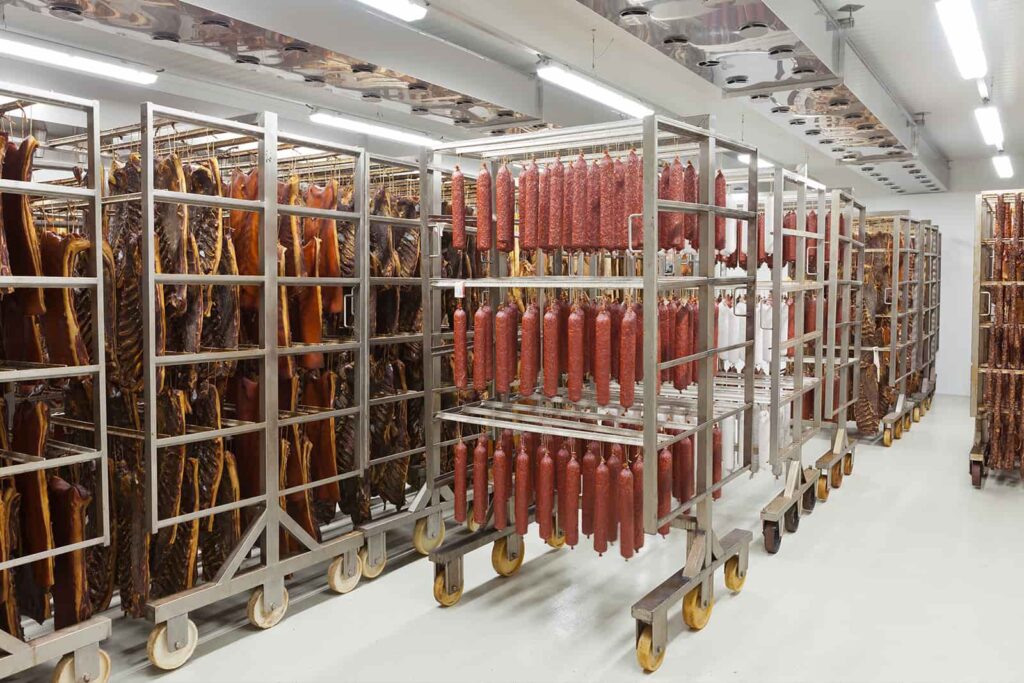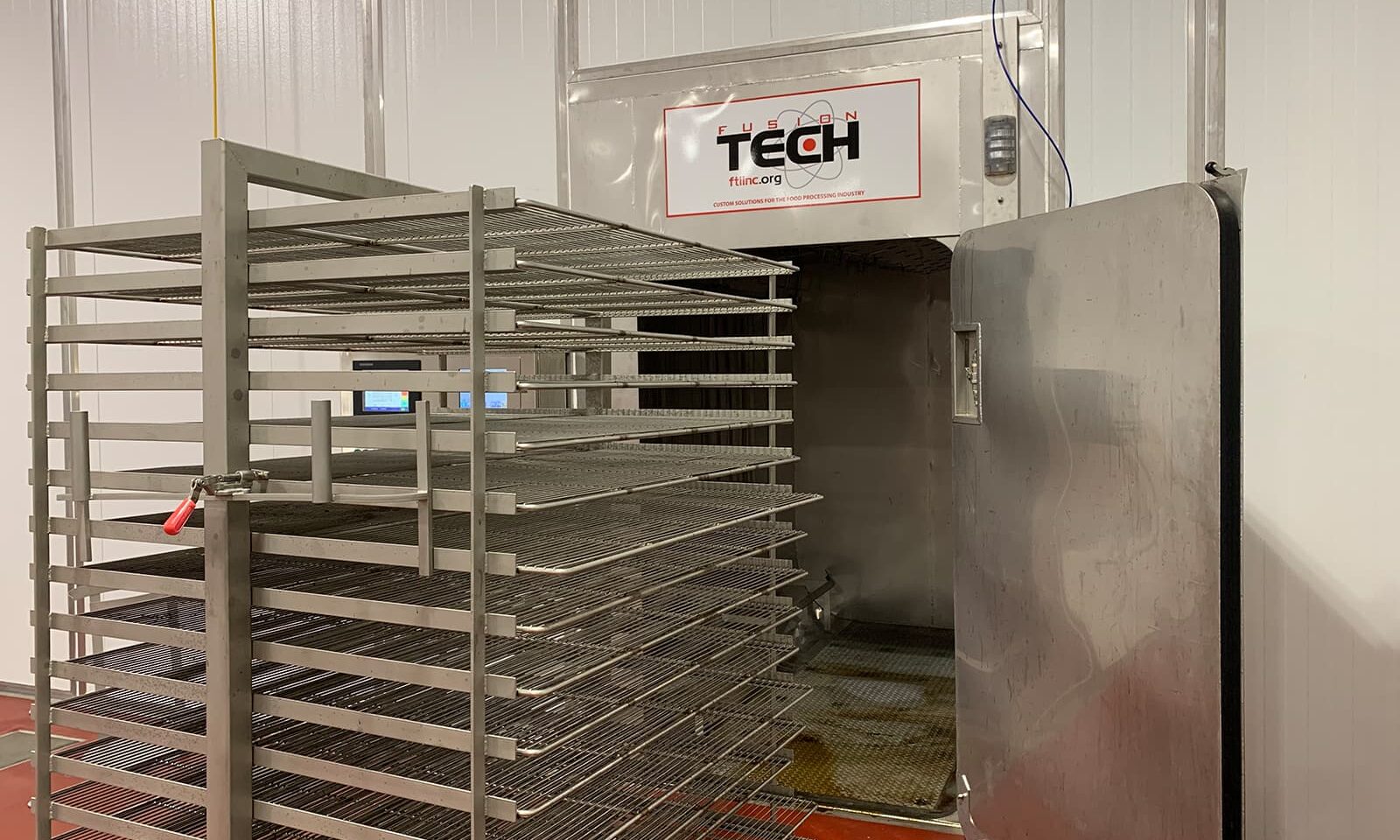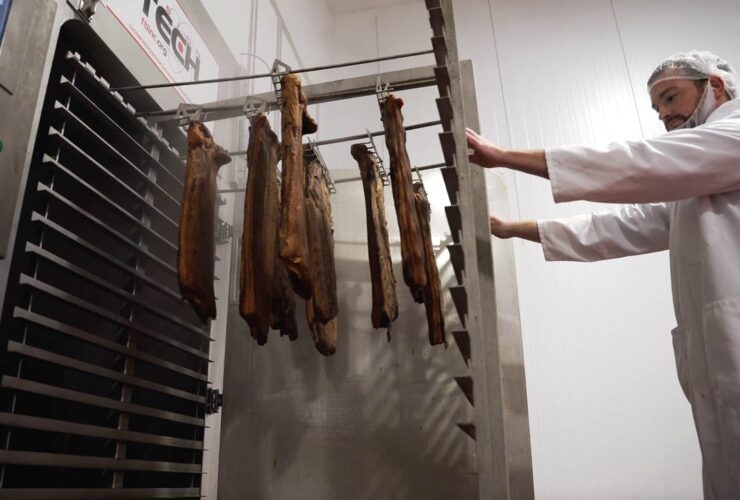If you are in the meat processing business, you know that cooking and smoking meat is an essential step in producing high-quality products. But when it comes to choosing the right smokehouse, the options can be overwhelming.
One of the biggest decisions in this regard is whether to opt for a single-wide or double-wide oven.
Most larger processors immediately opt for a double-wide oven — double the capacity means you’ll make more product, faster, right?
Not necessarily.
There are other factors to consider, such as the difference in throughput, labor, and yields between a single-wide and double-wide oven.
Often, a double-wide oven is going to slow production and decrease yields.
We’ll explain why that is in this article.
Understanding the Difference Between Single-Wide and Double Wide Ovens
Before we dive into the science behind why a single-wide oven is the best choice for throughput, labor, and yields, it makes sense to look at some of the design differences between the two.
The Basics of Single-Wide Ovens
Single-wide ovens are designed to have a single, straight path for the truck of meat to move through.
As the name implies, they are one truck wide and can range from two up to eight or even twelve trucks long.
 You will often find truck rails along the floor of a single-wide oven, making it easy for operators to know where to align the trucks for optimal airflow.
You will often find truck rails along the floor of a single-wide oven, making it easy for operators to know where to align the trucks for optimal airflow.
A few other features and benefits to note:
- Easier to cook smaller batches
- Less room for human error when loading trucks into the oven
- Stronger breakpoint across your product (more on that later)
- Fewer hot and cold spots (again, more on that later)
Most larger processors see a single-wide oven as too small for the amount of product they need to produce, but we’ll show you why this isn’t the case.
The Basics of Double-Wide Ovens
Double-wide smokehouses, as the name suggests, have a wider area for trucks of meat to be placed in. They fit two trucks wide as opposed to just one.
Double-wide smokehouses generally have more capacity than single-wide smokehouses and can handle larger volumes of meat.
While this may sound like the defining reason to purchase a double-wide oven, there are some issues to consider.
The biggest one is the lack of rails to position trucks in the optimal spot for airflow. A crooked truck, placing trucks too close together, or even only partially loading a double-wide oven can cause major airflow issues, which results in inconsistent yields.
A few other issues to consider:
- Much higher room for human error when loading trucks into the oven
- More difficult for the breakpoint to make it across the full oven (more on that later)
- More hot and cold spots (again, more on that later)
Often, the allure of more capacity comes at the expense of more labor, slower cook times, and inconsistent yields.
Breakpoints and Airflow
The biggest talking point between single-wide and double-wide ovens comes in the form of the breakpoint.
Now, we won’t do an extensive explanation of the breakpoint in this post. You can find that in our Oven Breakpoint Guide, complete with gifs showing how air moves in an oven.
But, there are a few key differences you need to understand.
Breakpoints (Briefly) Explained
 There are two streams of air (high velocity and low velocity) coming out of the supply ducts that crash together to create the breakpoint.
There are two streams of air (high velocity and low velocity) coming out of the supply ducts that crash together to create the breakpoint.
That breakpoint moves horizontally across the truck at different heights, depending on the location of the dampers and where those air streams collide.
In a single wide oven, that breakpoint is able to flow straight across the truck to cook each piece of product on that level. Then, as the breakpoint moves to the other side of the oven, the breakpoint moves across those products again, helping to provide a more even cook.
In a double-wide oven, the breakpoint is not as able to flow straight across both trucks.
It often makes it across most of a single truck before heading up into the return duct.
This results in a lot more inconsistencies in yields, product coloring, and cook time.
Hot and Cold Spots
Every oven has hot spots and cold spots.
Now, some processors and manufacturers will tell you that their oven doesn’t have either. The physics of airflow moving in an oven means there will be spots on your truck that cook faster (hot spots) and cook slower (cold spots).
A double-wide oven multiplies those hot and cold spots.
This means trying to achieve consistent yields across the truck and throughout the oven is going to be more difficult.
Yields and Consistency
Breakpoints and airflow lead us to the most important consideration between a single-wide and double-wide oven:
Yields and consistency.
Now, achieving yields and consistency in an oven is a very nuanced topic and is impacted by:
- Breakpoints and airflow (covered above)
- Product conditioning
- Product cadence
- Product cooking
Let’s look at examples of each of these.
Product Conditioning
As we mentioned, there are hundreds of different scenarios we could go through here, but we’ll use one as an example.
Let’s say you’re smoking a product.
You need to condition that product to take the smoke so it can gain color and consistency.
In a single wide oven, you’re able to condition that product faster — to get the entire surface of each piece of product conditioned to take smoke.
So, let’s say you’re using a single-side oven and conditioning your product for hardwood smoke or atomized smoke, and it takes 45 minutes to accomplish.
In a double-wide oven, that same process can take an hour and a half or longer to accomplish.
Here’s why — more product in a double-wide oven means:
- It takes longer for a batch to equilibrate
- There’s a lot more humidity in the oven
- It’s harder for the oven to condition that air to handle the humidity
In an 8-hour cook, that 45-minute reduction in just that one step is around a 10% reduction in cook time.
On top of that, by having a more consistent product that hasn’t sat in the oven waiting for a full batch to run, you’re going to gain yields.
In a double-wide oven, the product is going to naturally condition more on the edges of the truck than it will towards the center — meaning the product on the edges is evaporating more moisture before the center of the oven.
This causes you to lose yield on the product while trying to get things more equilibrated.
Product Cadence
You also need to consider product cadence — the process your product goes through before and after cooking.
- How are you prepping the product?
- Where are you placing trucks before loading the oven?
- How are you loading it into the oven?
- What are you doing with trucks during pack-out?
All of those elements have an effect on the yields and consistency.
 This is the biggest issue we see when working with larger processors who have double-wide ovens.
This is the biggest issue we see when working with larger processors who have double-wide ovens.
They looked at the overall capacity of an oven and figured a 16-truck (double-wide) was better than an 8-truck (single-wide), but they didn’t take into account everything that happens before cooking and how it affects their product.
Here’s an example to better explain what we mean.
Stuffing Example
Let’s say you’re stuffing out an 8-pound deli ham using a Marlin stuffer with regular clip collagen and are able to do 12 pieces per minute.
Following the math, that means you’ll get:
- 160 pieces per truck (20 pieces per layer with 8 layers)
- That’s 1200 to 1300-pound truck
Now, for an 8-truck, single-wide oven, it’ll take you
- 2 hours to fill 8 trucks
- One 15-minute break
For a 16-truck, double-wide oven, it’ll take more than double that:
- 4 hours to fill 16 trucks
- One 15-minute break
- One 30-minute lunch break
Using a single-wide, 8-truck oven means you:
- Reduced the time by 25%
- You are already 2 hours ahead of cooking than if you waited to fill a 16-truck oven
First Truck vs Last Truck
You also need to think through what happens when you’re loading products onto the trucks.
Using the example above, the first truck you fill for a double-wide oven will likely sit for 3-4 hours while the remaining trucks are loaded.
This causes a wide variety of yield variance and quality variance, in terms of color and texture that you don’t encounter in a single wide oven.
So, let’s say:
- The first truck was stuffed at hour 0
- The last truck was stuffed at hour 3
Most processors will keep their trucks in the 38°-40° range in a staging area while waiting to go in the oven. Some will just keep them in ambient conditions, like 50°.
Within those 3 hours, the product surface on truck 1 will start to warm up and sweat a bit. It will have more surface moisture than the product on truck 16. This means it’s going to be more challenging to condition or dry the product on truck 1 — making it harder to achieve consistent yields between truck 1 and truck 16.
Let’s say you weigh the product as it gets stuffed and then weigh the truck right before it enters the oven.
In truck 1, you may be losing 0.25% or 0.50% yield just from the product losing moisture while in staging.
Those numbers may not seem like a lot, but even a quarter % yield over the course of a month or two is a pretty significant poundage when you’re a plant going through 100-200,000 pounds per day.
That little bit of variance makes a HUGE difference.
The same is true in reverse.
Let’s say you stage your trucks in a cooler at 34°.
Truck 1 is going to be much cooler than truck 16 which is fresh off the production floor.
Truck 16 will have more moisture on it while Truck 1 will be much drier.
This means you’ll still have yield variance making it hard to get a consistent cook.
Loading the Oven
The time it takes and how you load a single-wide 8-truck versus a double-wide 16-truck oven affects yields and consistency as well.
It roughly takes 15-20 minutes to load an 8-truck, single-wide oven and upwards of 30-40 minutes (or more) to load a 16-truck, double-wide oven.
 That’s more time for product variation to occur on truck 1 versus truck 16.
That’s more time for product variation to occur on truck 1 versus truck 16.
How you load the ovens matters as well.
In a single wide oven, you have rails on each side that help ensure the trucks are in the right place for airflow and the breakpoint to move across.
In a double-wide oven, it’s easy to have trucks pushed too close to each other in a way that limits or negatively impact the breakpoint and airflow.
There’s far more room for human error loading a double-wide oven that results in inconsistent yields.
We dive deeper into the right way to load ovens for airflow in this article.
Better Yields
Getting product into the oven sooner, getting the oven started sooner, is going to give you better yield numbers, better quality, and better consistency.
You’ll notice less variation in coloring from one end of the oven to the other and better per-piece yields using a single wide, 8-truck oven versus a double wide, 16-truck oven.
Better Utilization of the Oven
This all leads to another benefit of a single-wide oven – better utilization of the oven.
A double-wide oven will sit around empty longer than a single-wide, not cooking, while production is making the 8 extra trucks.
In a single-wide, you fill up 8 trucks and are able to start the oven right away.
It may have less capacity, but you’ll utilize it better and achieve better yields and consistency.
Which Oven is Better?
To recap, there are a lot of factors that impact yields and consistency in your cook cycle, including:
- Airflow and the strength of the breakpoint
- Product staging
- Loading the oven
- Product conditioning
- Cook time
When comparing a single-wide oven to a double-wide oven in all of these factors, a single-wide will always provide better results.
Don’t only consider oven capacity.
We’ve worked with clients who see much better yields and consistency out of their single-wide, 8-truck oven than their double-wide, 16-truck oven for all the reasons we listed above.
Still not sure which oven is right for your facility?
Our food scientists are happy to talk through the factors you need to consider and help you choose the oven that makes sense for you.
You can contact us here to arrange a call or visit our Ovens page to learn more.





